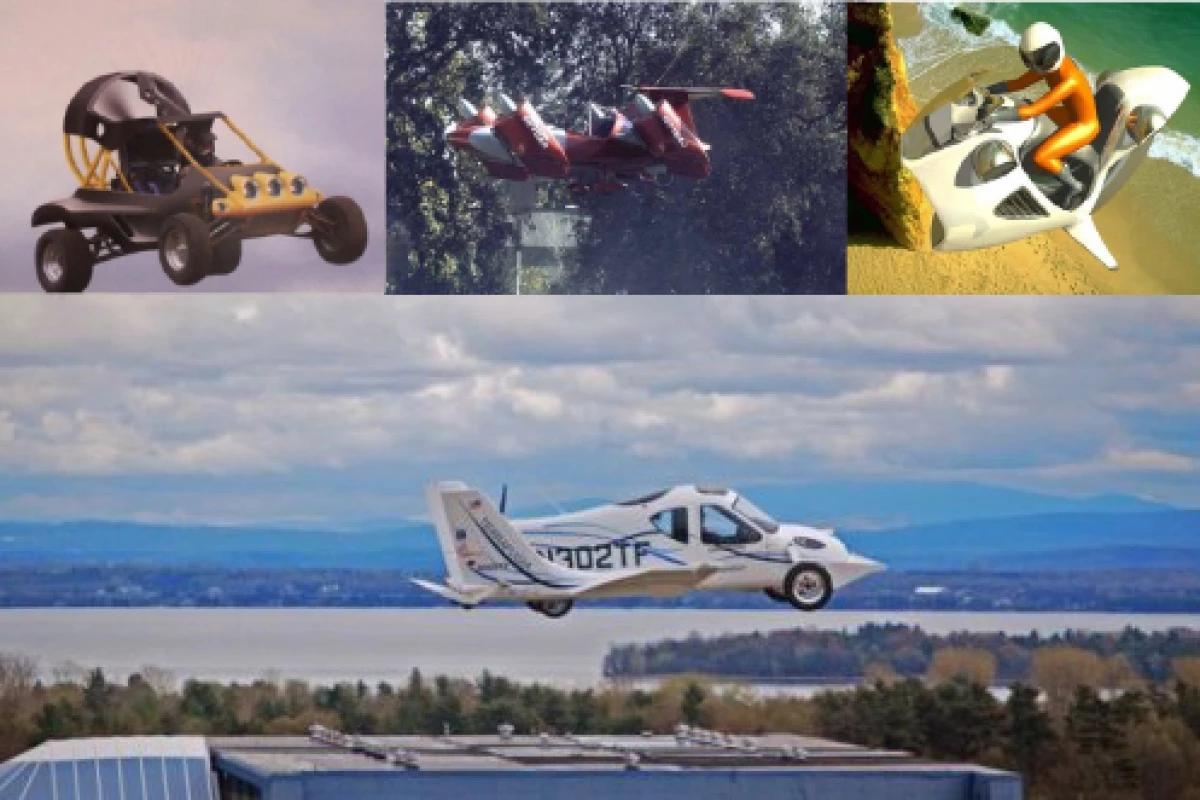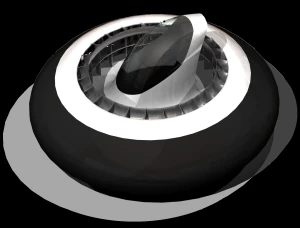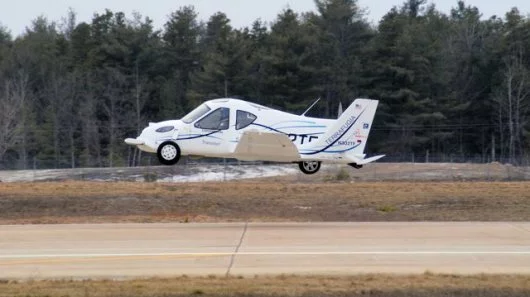Flying cars are back in the news this week with the Terrafugia Transition gaining FAA certification as a road-registerable aircraft. Exciting stuff, but the Transition doesn't quite satisfy our fantasies of being able to just press a button and lift off out of traffic, landing on the roof of our city office building to make that 9am meeting; it's basically a light plane with retractable wings that you can drive on the road – you're still stuck taking off and landing at airstrips. So here's a quick look over what else is out there and in development in the world of flying cars and motorcycles … with a bonus look at some personal flying saucers, a flying boat and a few concepts that will never get off the ground.
Flying cars: the main players
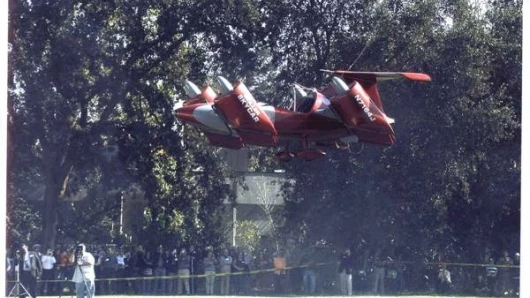
Paul Moller has been trying to build a flying car for nearly 30 years, and at a cost of more than US$100 million – that should give you some measure of how hard the task is. The M400 is a four-seater car capable of automatic flight using four ducted fans.
Most of the complex flight dynamics of the vehicle are computer controlled, meaning that the pilot uses a few simple controls to direct the craft, and the computer takes care of things like stability and proportional fan speeds. Top airspeed would be in the 330 mph range, and altitudes of 36,000 ft would be reachable.
The SkyCar was last seen flying in 2003 in a small tethered test hover. Last we heard it will next be tested in 2012, and production versions are said to be slated for a few years on from that. Pricing is believed to be around the US$100,000 mark, but we wouldn't be holding our breath. More about the Moller Skycar.
Also check out Moller's recent hybrid autovolantor, based on a Ferrari 599 GTB.

Parajet has taken a distinctly different approach to the flying car problem, eschewing high speed flight for something much cheaper and arguably safer. The Parajet Skycar is effectively a powered paraglider in the air and a monster dune buggy on the ground. Powered by a ripping 140-horsepower Yamaha R1 engine, it's a hooligan tool on the road or the sand dunes, but when you switch the power over to the large rear fan and deploy the enormous parachute wing, the Parajet can take off within about 500 ft and reach heights of up to 3,000ft.
The Parajet Skycar was successfully tested in January 2009 with a 42-day, 9,000km expedition from London down to Mali's Timbuktu and back again. The production SkyCar can be ordered now for around GBP 50,000. More about the Parajet SkyCar.
The Transition is much more of a "roadable aircraft" than a flying car, but thanks to a bit of rule relaxation by the FAA, it's just become the first road-registered Light Sport Aircraft in the USA. You need to be able to fly a plane to get this puppy off the ground – and that's essentially what it is, a light plane with a rear propeller and full-size wings that fold up automatically within 30 seconds when it's time to be Earthbound.
In plane form, the Transition can cruise at 115mph ground speed to a range of 460 miles. On the road, it'll fit into a garage or parking spot easily, and carries a driver and passenger.
Sales have been very brisk – Terrafugia is dealing with a backlog of more than 70 orders at around US$194,000 a pop and the first customer deliveries are expected by the end of 2011. So there's clearly a market for a readable recreational aircraft out there. More about the Terrafugia Transition.
Flying saucers
I think if you asked most people, they wouldn't give a hoot whether their flying car was actually road-registerable. It's really more about the ability to jump in a personal vehicle and fly from A to B, soaring above traffic and skipping all the toll booths and speed cameras on the ground.
In that spirit, it's probably worth considering these two flying saucer-type devices that offer a glimpse into what might be possible.
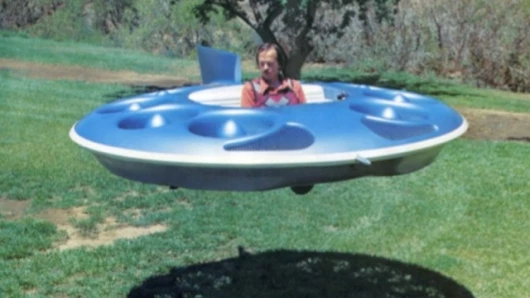
Where's Elroy got to? The Jetson is a one-man, VTOL flying saucer with a 10-foot flight ceiling and a fly-by-wire-system that basically just requires the pilot to push a stick in whatever direction he/she wants to go, and does the rest automatically. It can be road registered in a limited fashion, it can travel around 100 miles in the air at a max speed of 100mph – and there's talk of an M200E kit version that doesn't have the software-imposed 10-foot flight ceiling. In 2009, these nifty flying saucers were being auctioned on eBay with a US$150,000 reserve.
See a video of a test flight over at the More about the Entecho Hoverpod.
Flying motorcycles
A lot of the hassle in getting a flying car onto the market comes with the dual compliance you need to get to register it both as an airplane and as a road vehicle. In the case of cars, you can't sell a car in the US without a whole bunch of safety features that end up weighing it down and making it a very expensive proposition.
Motorcycles, though, exist in a wonderful class of their own - they're recognized as a high-risk vehicle both by riders and the government, so there's much less to do to get a bike registered on the road than with a car. Multi-mode vehicle makers have taken advantage of this by designing flying three-wheelers that satisfy both the FAA and the DMV. Here's a few significant flying motorcycles:
The Super Sky Cycle is about as bare-bones as it comes. It rides the highway as a trike, and takes to the sky as a simple gyroplane. It's already road-registered and on sale in the USA for less than 40 grand if you buy it as a kit. It fits happily into the average garage, being around the size and height of a panel van, and it takes just a couple of minutes to whip out the wings, switch the drivetrain over to flight mode, and get yourself in the air. Yeeee-haaaa! More about Larry Neal's Super Sky Cycle.
Allied Aerotechnics' VTOL Airbike
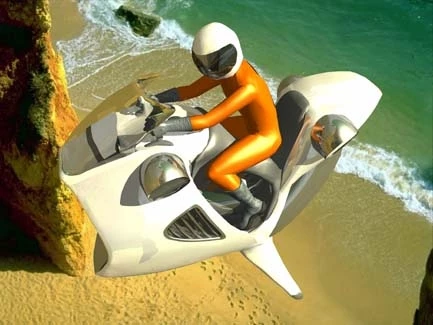
It's a pity this one never made it off the ground. Dubbed the '"Flying Ducati", the idea was to lift the AirBike off the ground using vectored thrust from a couple of contra-rotating ducted fans. Radio-controlled prototypes were made and crashed, then re-made better, and the last we heard, Allied was looking into making a full-scale prototype for testing. Range was going to be more than 2,000km, and maneuverability looked great, making it an exciting concept.
Sadly, despite having been working on the SkyBike from at least 1984 until 2003, the trail runs cold and the AeroBiker website now has nothing but a placeholder. More about Allied Aerotechnics' VTOL Airbike.
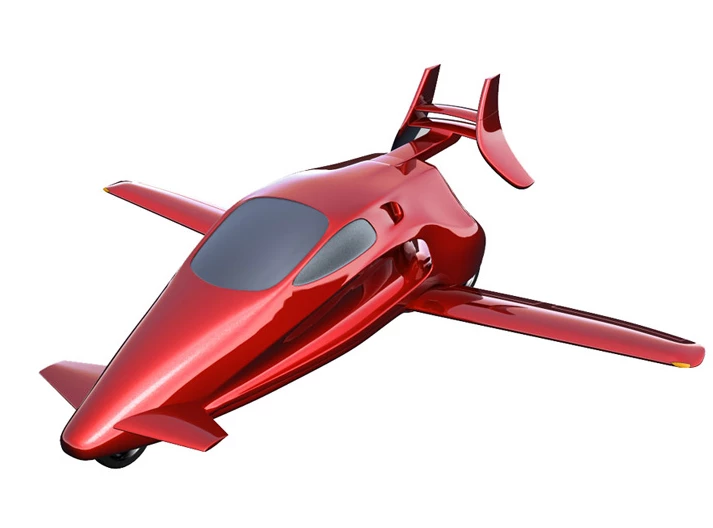
These guys are running full steam at the prize as we write, banging together road and sky prototypes using seriously fun engines like Suzuki's Hayabusa donk, which generates up to and beyond 180 horsepower. The Switchblade is a fully-enclosed trike that takes to the air using a rear-mounted prop and a pair of scissor-action wings that fold out from beneath the vehicle.
The Switchblade is envisioned as a pretty classy little vehicle in completion - the body shape will be Ferrari-inspired and the switchover from road to flight modes should be fully automatic at the touch of a button. As a prop plane rather than a kit gyroplane, the Switchblade will have a longer range and higher air speed than the Super Sky Cycle, so it's definitely one to keep an eye on. It also looks a heck of a lot like a car, with the rider and passenger sitting side by side in an enclosed cabin. Nice! More about the Samson Switchblade.
Pie-in-the-sky concepts
The idea seems so simple – it's just gotta fly and drive, right? Sadly, the process of bringing a fully fledged flying car design anywhere near production is both hugely expensive and fraught with technical challenges. So here's a couple of flying car concepts that are unlikely ever to get past the drawing board, but that we thought were worth a look.
The Haynes Skyblazer roadable aircraft
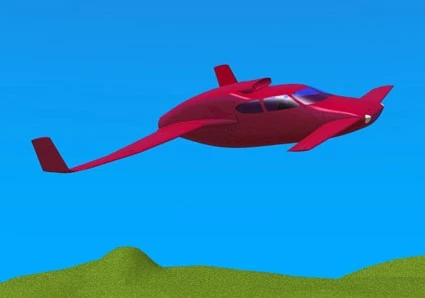
The Skyblazer uses the kind of folding wing technology seen on a carrier-based jet in order to convert automatically from a 250mph personal jetplane to a road car that's supposed to fit into a garage or a parking space. Still, it doesn't look like a lot has happened since around 2007, and at this stage the Skyblazer is just a design drawing. More about the Haynes Skyblazer.

Now that's what I'm talking about! Four big, fat turbines that rotate to produce vertical or horizontal thrust. VTOL. Hovering. Twin-joystick control … Gino Gizio's concept is as future-funky and pie-in-the-sky as they come. His skill in aerospace design is only matched by the awesome Flash and Photoshop skills he demonstrates at his personal website. Go Gizio! More about the Gizio G440.

To be fair, the YEE was conceived by a group of Chinese industrial design students, so it's really more of a form study than a serious flying car idea. But it's so misguided we just have to include it!
The YEE's forward-angled wings (!) fold downward to become outrigger stabilizers (!) during road use, with small wheels on their tips. The twin rear propellers then fold together to form a rear wheel. So … you use the driven rear wheel to speed up to takeoff velocity, and then, just as you lift off, you have to wait for the wheel to fold out into a pair of props before you have any forward thrust, during which time you have no wheel to land on if you run out of lift. Good thinking, guys! More about the YEE Flying Car Concept.
…and a flying amphibious car!
The Ramphos Amphibious flying boat/car/thing
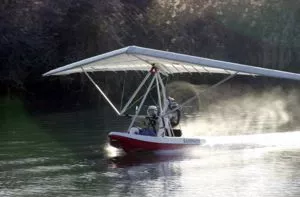
The Ramphos is cheating a bit – it flies and it floats and it drives, but it was never intended to be a road-registered flying car. Instead, it's a multi-mode recreation vehicle that's designed to be towed to an airstrip or boat ramp and then let loose.
But it's the only jigger on our list that would let you fly over to a lake, land on the surface of the water, then drive up the boat ramp, wave cheerily to slack-jawed onlookers and leave. Test pilots say it's easy and fun to fly. You can buy one of these crazy looking contraptions for around US$35,000. More about the Ramphos.
